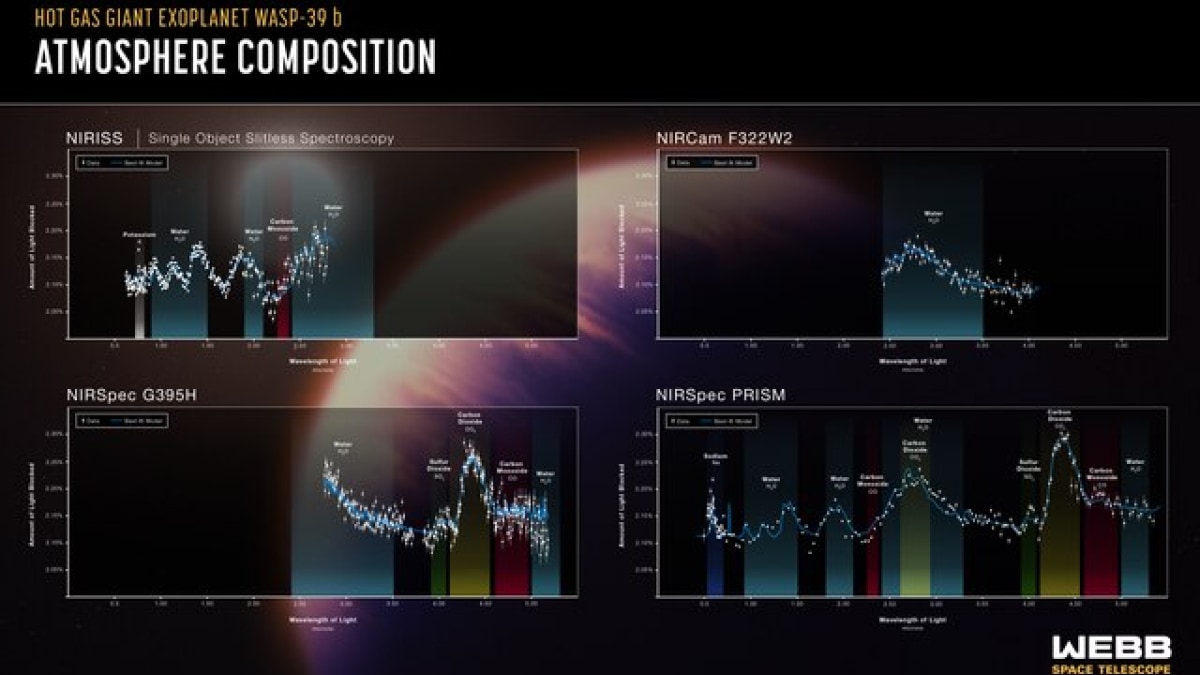In a groundbreaking study, astronomers have successfully analyzed the atmosphere of WASP-166 b, a hot super-Neptune exoplanet, using data from the James Webb Space Telescope (JWST). This exoplanet, located approximately 368 light-years away, has revealed intriguing details about its atmospheric makeup, including the presence of water and carbon dioxide. The findings also detect trace amounts of ammonia, adding new dimensions to our understanding of distant worlds.
Introduction to WASP-166 b
WASP-166 b is an intriguing hot super-Neptune orbiting its host star in a relatively short period of just 5.44 days. This exoplanet is significantly larger and heavier than Earth, with a size approximately seven times that of Earth and a mass about 32 times heavier. Situated in the hot Neptune desert, it has an equilibrium temperature of 1,270 K.
At this temperature, WASP-166 b lies within a category of exoplanets that challenge current planetary formation theories, especially those involving planets in close orbits around their stars. The atmosphere of this exoplanet has sparked significant interest due to its unique composition, which is further explored through advanced observational techniques.
Insights from James Webb Space Telescope Observations
Using the state-of-the-art tools onboard the James Webb Space Telescope (JWST), astronomers studied WASP-166 b’s atmosphere with remarkable precision. The JWST’s Near Infrared Imager and Slitless Spectrograph (NIRISS) and the Near Infrared Camera (NIRCam) provided invaluable data, offering an in-depth look at the exoplanet’s atmospheric composition.
Key findings include the detection of water vapor and carbon dioxide as dominant elements in the planet’s atmospheric spectrum. These findings suggest that WASP-166 b possesses a diverse and complex atmospheric system, providing scientists with clues about planetary formation in such extreme environments. Furthermore, the observations also revealed ammonia in smaller quantities, hinting at the potential presence of chemical processes at play.
Despite extensive searches, no significant evidence for compounds like carbon monoxide was found, suggesting that certain expected elements might not be present in the planet’s atmosphere in substantial amounts. The remaining atmosphere is likely composed of helium and hydrogen, in a primordial solar ratio, which is common for exoplanets in this category.
Host Star WASP-166: A F9V Star
The host star of WASP-166 b, designated WASP-166, belongs to the F9V spectral type, making it larger and more massive than our Sun. This star is about 20 percent larger and more massive than the Sun and is approximately 2.1 billion years old. It boasts a surface temperature of around 6,050 K and has a metallicity of 0.19 dex.
WASP-166’s unique characteristics influence the planetary system that includes WASP-166 b. The study of both the planet and its star offers significant insights into stellar evolution, helping astronomers refine their models for planetary formation and system dynamics in distant star systems.
Atmospheric Composition and Carbon-to-Oxygen Ratio
One of the most intriguing aspects of the study is the determination of the carbon-to-oxygen ratio of WASP-166 b. The ratio was found to be 0.282, which is significantly lower compared to the host star’s carbon-to-oxygen ratio of 0.41 and the Sun’s ratio of 0.55. This disparity could have important implications for the planet’s formation history and the processes that led to the development of its atmosphere.
Additionally, the planet’s high atmospheric metallicity, reported at 1.57, presents another noteworthy detail. This could suggest that WASP-166 b may have undergone specific processes, such as planetesimal accretion or core erosion, that affected its composition over time.
Explanations for WASP-166 b’s Atmospheric Makeup
The study offers several possible explanations for the unique atmospheric composition of WASP-166 b. One theory is that the planet’s atmosphere could be the result of planetesimal accretion, where the planet accumulated a large amount of material from its surroundings during its formation. This process could have contributed to the presence of water, carbon dioxide, and other gases.
Alternatively, core erosion might have played a role in shaping the atmosphere. This process, wherein the planet’s interior materials are gradually lost to space, could explain the observed presence of certain atmospheric compounds and the lack of others.
Another possibility is photoevaporation, a process where intense radiation from the host star strips away lighter elements from the planet’s atmosphere, potentially leaving behind heavier compounds like water and carbon dioxide. This mechanism is often observed in close-orbiting exoplanets, particularly those in the hot Neptune desert.
The Hot Neptune Desert and Implications for Planetary Formation
WASP-166 b resides in a region known as the hot Neptune desert, a term used to describe a scarcity of exoplanets in this size and temperature range. The findings from this study contribute to a growing understanding of planetary formation in such environments and the factors that influence the chemical composition of exoplanetary atmospheres.
The research on WASP-166 b provides important insights into the diversity of exoplanetary systems, shedding light on how planets form and evolve, particularly in close proximity to their stars. These findings underscore the complexity of exoplanetary atmospheres and suggest that planets in the hot Neptune desert might exhibit a variety of atmospheric compositions depending on their specific formation histories.
Conclusion: A Step Forward in Exoplanet Exploration
The observations of WASP-166 b from the James Webb Space Telescope represent a significant leap in our understanding of exoplanets located in extreme environments. By analyzing the planet’s atmosphere, astronomers have gained new insights into the presence of water, carbon dioxide, and ammonia, while also exploring potential explanations for the planet’s unique composition.
These findings not only enhance our knowledge of WASP-166 b but also offer broader implications for the study of planetary systems across the universe. As JWST continues its observations of distant exoplanets, we can expect more discoveries that will shape our understanding of the diversity and evolution of planets far beyond our solar system.
For further information on exoplanet research and JWST’s role in space exploration, you can visit popular sites like NASA Exoplanet Exploration and James Webb Space Telescope.







